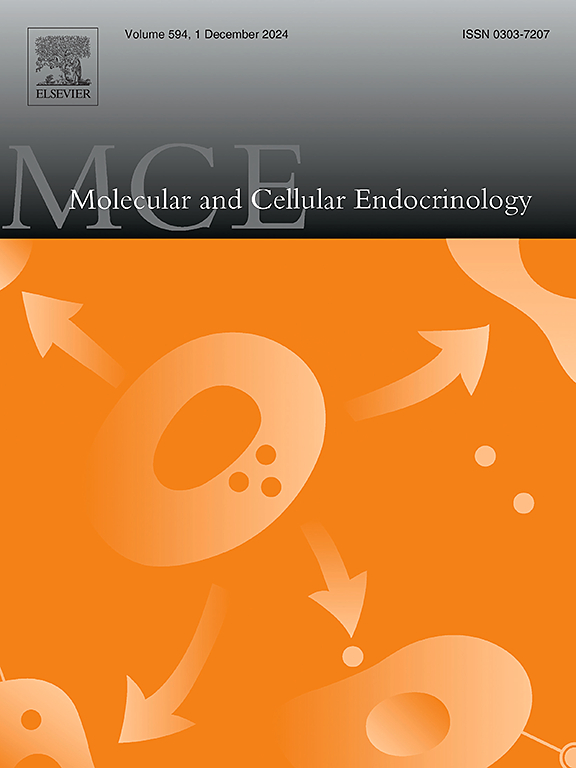Mass spectrometric profiling of primary estrogens and estrogen metabolites in human stool and plasma partially elucidates the role of the gut microbiome in estrogen recycling
IF 3.6
3区 医学
Q2 CELL BIOLOGY
引用次数: 0
Abstract
Primary estrogens and estrogen metabolites are commonly measured in human plasma and serum, but there exist almost no recent reports for human stool. This knowledge gap limits our understanding of the relationships between systemic and gut estrogens. We developed a highly sensitive liquid chromatography-mass spectrometry/mass spectrometry (LC-MS/MS) method to determine, in human plasma and stool, the free and conjugated levels of estrone, estradiol, and estriol together with their additional hydroxyestrogen and methoxyestrogen metabolites. We investigated human stool and plasma estrogens in healthy control men; in follicular and luteal phase premenopausal women; and in postmenopausal women. Most estrogens were present in plasma and stool of all groups, while the plasma and stool levels of hydroxyestrogen and methoxyestrogen metabolites but not estrone were correlated. In stool, estrogens were higher in premenopausal women, with estrogens increasing across the menstrual cycle. We combined these LC-MS/MS measures with shotgun metagenomic sequencing of the stool microbiomes. Estrogen deconjugation enzyme gene copy numbers (β-glucuronidase and arylsulfatase) were higher in premenopausal women; while the gene copy number of β-glucuronidase + arylsulfatase, but not β-glucuronidase alone, correlated with deconjugated stool estrogens in all groups. Moreover, β-glucuronidase + arylsulfatase gene copy numbers correlated with combined plasma estrogens in men and with individual plasma estrogen metabolites in men and premenopausal women. These results support the hypothesis that gut microbial β-glucuronidase and arylsulfatase control the deconjugation of gut estrogens while modulating systemic levels through the uptake and recirculation of these deconjugated estrogens. The intestine may thus constitute an important additional compartment in estrogen physiology.
人体粪便和血浆中初级雌激素和雌激素代谢物的质谱分析部分阐明了肠道微生物组在雌激素循环中的作用。
原发性雌激素和雌激素代谢物通常在人血浆和血清中测量,但最近几乎没有关于人粪便的报道。这种知识差距限制了我们对全身雌激素和肠道雌激素之间关系的理解。我们开发了一种高灵敏度的液相色谱-质谱/质谱(LC-MS/MS)方法来测定人血浆和粪便中雌酮、雌二醇和雌三醇及其附加的羟雌酮和甲氧雌酮代谢物的游离和共轭水平。我们调查了健康对照男性的粪便和血浆雌激素;在卵泡期和黄体期绝经前妇女;绝经后的女性也是如此。各组血浆和粪便中均以雌激素居多,而血浆和粪便中羟雌酮和甲氧雌酮代谢物水平相关,雌酮水平不相关。在粪便中,绝经前妇女的雌激素含量较高,在整个月经周期中雌激素含量增加。我们将这些LC-MS/MS测量与粪便微生物组的霰弹枪宏基因组测序相结合。绝经前妇女雌激素解结酶基因拷贝数(β-葡萄糖醛酸酶和芳基硫酸酯酶)较高;而β-葡萄糖醛酸酶+芳基硫酸酯酶基因拷贝数与各组解结性粪便雌激素相关,而β-葡萄糖醛酸酶基因拷贝数与解结性粪便雌激素无关。此外,β-葡萄糖醛酸酶+芳基硫酸酯酶基因拷贝数与男性联合血浆雌激素以及男性和绝经前女性个体血浆雌激素代谢物相关。这些结果支持了肠道微生物β-葡萄糖醛酸酶和芳基硫酸酯酶控制肠道雌激素的解偶联,同时通过这些解偶联雌激素的摄取和再循环调节全身水平的假设。因此,肠道可能是雌激素生理学中一个重要的额外隔室。
本文章由计算机程序翻译,如有差异,请以英文原文为准。
求助全文
约1分钟内获得全文
求助全文
来源期刊

Molecular and Cellular Endocrinology
医学-内分泌学与代谢
CiteScore
9.00
自引率
2.40%
发文量
174
审稿时长
42 days
期刊介绍:
Molecular and Cellular Endocrinology was established in 1974 to meet the demand for integrated publication on all aspects related to the genetic and biochemical effects, synthesis and secretions of extracellular signals (hormones, neurotransmitters, etc.) and to the understanding of cellular regulatory mechanisms involved in hormonal control.
 求助内容:
求助内容: 应助结果提醒方式:
应助结果提醒方式:


